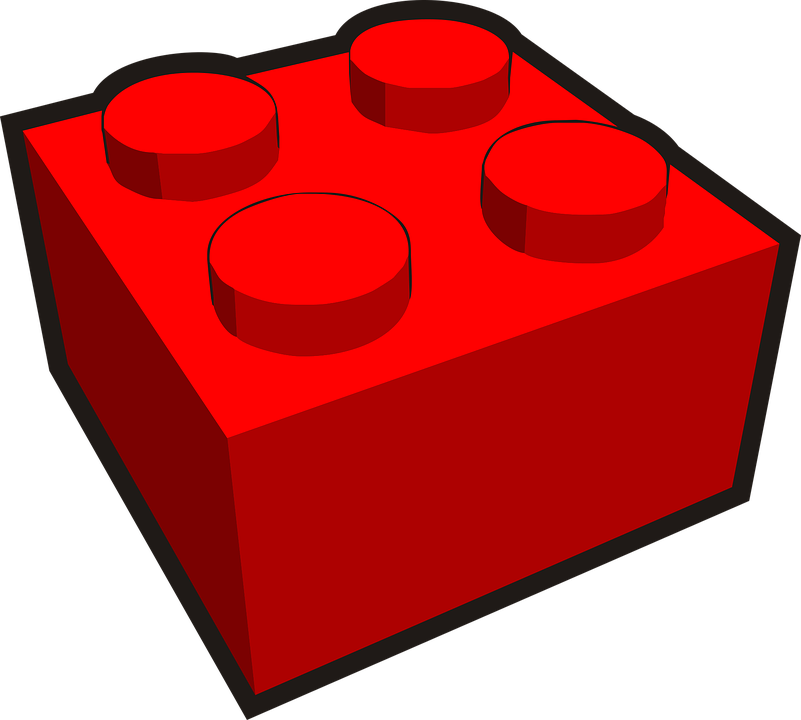
Algebra 2 by Richard Wright
Are you not my student and
has this helped you?
Objectives:
SDA NAD Content Standards (2018): AII.4.1, AII.4.2, AII.5.1, AII.5.2

When a factory makes a product such as a LEGO brick, it has to make it a certain size. There can be very error in the size. For LEGO, the amount of error can be up to 0.002 mm. This is called tolerance. The allowed sizes can be found by using an absolute value inequality.
Absolute values are the distance from the origin to the coordinate. |x| = b is saying the distance between x and 0 is b. |x – k| = b is saying the distance between x and k is b.
On a one-dimensional number line, the absolute value is simply the positive number. |−3| = 3
There are usually two solutions to an absolute value equation because the absolute value of both positive and negative numbers give the same thing. One solution comes when the expression in the absolute value is positive, the other solution comes with the expression in the absolute value is negative.
Solve |x + 2| = 8
Solution
$$ \begin{array}{rlcrl} & & |x + 2 | = 8 & & \\ x + 2 & = 8 & ← \text{ Write two equations } → & -(x + 2) & = 8 \\ x & = 6 & ← \text{ Solve each equation } → & x + 2 & = -8 \\ & & & x & = −10 \end{array} $$
Check the answers by substituting them into the original equation.
Check −10.
|−10 + 2| = 8
|-8| = 8
8 = 8
This is true, so −10 is a solution.
Check 6.
|6 + 2| = 8
8 = 8
This is true, so 6 is also a solution.
The solutions are x = −10 or 6.
Solve |4x − 2| = 6x.
Solution
|4x − 2| = 6x
$$ \begin{array}{rlcrl} (4x-2) & =6x & ←\text{ Write two equations }→ & -(4x-2) & =6x \\ -2 & =2x & ←\text{ Solve each equation }→ & 4x-2 & =-6x \\ -1 & =x & & -2 & =-10x \\ & & & \frac{1}{5} & =x \end{array} $$
Check the answers by substituting them into the original equation.
Check −1.
|4(−1) − 2| = 6(−1)
|−6| = −6
6 = −6
This is not true, so −1 is an extraneous solution meaning that is does not work in the original equation even though the solving process was done correctly.
Check \(\frac{1}{5}\).
$$ \left|4\left(\frac{1}{5}\right) - 2\right| = 6\left(\frac{1}{5}\right) $$
$$ \left|-\frac{6}{5}\right| = \frac{6}{5} $$
$$ \frac{6}{5} = \frac{6}{5} $$
This is true, so \(\frac{6}{5}\) is a solution.
The solution is x = \(\frac{1}{5}\).
Solve |2x − 3| = x + 7.
Solution
|2x − 3| = x + 7
$$ \begin{array}{rlcrl} 2x-3 & =x+7 & ←\text{ Write two equations }→ & -(2x-3) & =x+7 \\ x-3 & =7 & ←\text{ Solve each equation }→ & -2x+3 & =x+7 \\ x & =10 & & -3x+3 & =7 \\ & & & -3x & =4 \\ & & & x & = -\frac{4}{3} \end{array} $$
Check the answers by substituting them into the original equation.
Check \(-\frac{4}{3}\).
$$ \left|2\left(-\frac{4}{3}\right)-3\right| = -\frac{4}{3} + 7 $$
$$ \left|-\frac{17}{3}\right| = \frac{17}{3} $$
$$ \frac{17}{3} = \frac{17}{3} $$
This is true, so \(-\frac{4}{3}\) is a solution.
Check 10.
|2(10) − 3| = 10 + 7
17 = 17
This is true, so 10 is a solution.
The solutions are x = \(-\frac{4}{3}\) or 10.
Solve absolute value inequalities the same as equations. Remember when you multiply or divide both sides of an inequality by a negative number to flip the inequality sign.
When you write the answer, write it as a compound inequality. If both solutions can be true at the same time, such as x > 2 and x < 6, then write an AND or conjunction like 2 < x < 6. If both solutions cannot be true at the same time, such as x < 3 and x > 8, then write an OR or disjunction like x < 3 or x > 8.
Solve like an absolute value equation with the following differences.
Solve |3x − 5| > 1.
Solution
|3x − 5| > 1
$$ \begin{array}{rlcrl} 3x-5 & > 1 & ←\text{ Write two inequalities }→ & -(3x-5) & > 1 \\ 3x & > 6 & ←\text{ Solve each inequality }→ & 3x-5 & < -1 \\ x & > 2 & & 3x & < 4 \\ & & & x & < \frac{4}{3} \end{array} $$
Numbers cannot be greater than 2 and less than \(\frac{4}{3}\) at the same time, so the solution is a disjunction. See the graph on the number line.

The solutions are x < \(\frac{4}{3}\) or x > 2.
Solve |2 − x| ≤ 12.
Solution
|2 − x| ≤ 12
$$ \begin{array}{rlcrl} 2-x & ≤ 12 & ←\text{ Write two inequalities }→ & -(2-x) & ≤ 12 \\ -x & ≤ 10 & ←\text{ Solve each inequality }→ & -2+x & ≤ 12 \\ x & ≥ 10 & & x & ≤ 14 \end{array} $$
Numbers can be greater than 10 and less than 14 at the same time; 12 is an example. The solution is a conjunction. See the graph on the number line.

The solutions are 10 ≤ x ≤ 14.
In manufacturing, tolerance is the amount of allowed difference between the real-life measurement and the standard. Absolute value inequalities can be used to find if a given measurement is within tolerance.
|Actual − Standard| ≤ Tolerance

LEGO bricks are manufactured with small tolerances so that they always stick together. The standard width of a 2×2 brick is 15.8 mm with a tolerance of 0.002 mm. Write and solve an absolute value inequality that describes the actual widths of 2×2 bricks.
Solution
|Actual − Standard| ≤ Tolerance
|x − 15.8| ≤ 0.002
$$ \begin{array}{rlcrl} x-15.8 & ≤ 0.002 & ←\text{ Write two equations }→ & -(x-15.8) & ≤ 0.002 \\ x & ≤ 15.802 & ←\text{ Solve both inequalities }→ & x-15 & ≤ -0.002 \\ & & & x & ≥ 15.798 \end{array} $$
15.798 ≤ x ≤ 15.802
The widths of 2×2 LEGO bricks are between 15.798 mm and 15.802 mm.
Solve the equation.
Solve the inequality.
Tolerance Problems
Mixed Review
A theater has 40 rows with 20 seats in each row. If the first n rows cost $30 per seat and the rest cost $15 per seat, how much revenue does the theater earn when all the seats are sold?